This section showcases the collaborative efforts of our students through six distinct group projects completed during the course. Each group has worked to analyze, and present their findings on the themes of trauma and national identity across Japan, Lebanon and Modern-day Egypt. You will find posters and abstracts for each project, offering a glimpse into the research carried out by our students.
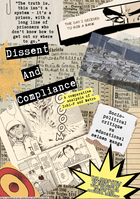
Alessandro di Vita and Jarand Holand
File [9333Kb .pdf]
Title: Dissent and compliance: A socio-political analysis of Ichi-F and Metro
Abstract
This report presents a comparative analysis of the two comics Ichi-F (2013-2015) and Metro (2008), focusing on how they engage with traumatic events and national identity formation. By looking at the social and political context of their creation and the tradition of comics in their respective countries, the aim is to highlight how these mainstream and non-mainstream narratives approach traumatic events and national identity in particular ways. We use two intersecting perspectives of comics to analyze the works: comics as entertaining consumption and comics as socio-political critique. Our main argument is, on the one hand, that Ichi-F engages with the Fukushima disaster in an uncritical, ‘matter of fact’ way, presenting the author’s daily experiences of the cleanup work in the nuclear facility. At the same time, it is far from the spectacle of other mainstream media. On the other hand, Metro, while a fictional work, is a vehicle of resistance and social expression, drawing attention to the structural violence and repression under Mubarak’s military regime with pointed critique against corrupt authorities and social problems. The two narratives stand in opposition as narratives of dissent and compliance, drawing lines of national identity with or across authorities and institutions.
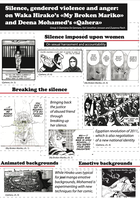
Damiana De Gennaro, Zuzanna Piech, Karl Jonathan Jonsson
File [5934Kb .pdf]
Title: Silence, gendered violence and anger: on Waka Hirako’s «My Broken Mariko» and Deena Mohamed’s «Qahera».
Abstract
We will compare the manga My Broken Mariko by Waka Hirako (2019) to the Egyptian webcomic Qahera by Deena Mohamed (2013), highlighting strategies for breaking the silence associated with gendered violence, thereby suggesting the possibility of overcoming traumatic experiences. My Broken Mariko revolves around a woman who steals the ashes of her best friend who committed suicide after being a victim of sexual abuse, intending to set her free, while Qahera portrays a female superhero fighting the daily sexual harassment faced by Egyptian women. Stella Oh's work provides insights into handling emotionally charged topics with sensitivity and respect, while Jacob Høigilt’s shows how adult comics create alternative spaces on a national level against patriarchal authoritarianism.
In My Broken Mariko, darkness and grief represent trauma and silence in a josei style, which will be compared to Qahera, a webcomic using darkness and silhouettes to depict surroundings threatening its female characters. For both works, we will refer to the Michele Mason’s analysis of Nakazawa Keiji’s Black Series Manga to show how character’s behavior against antagonists reflects grief and rage after traumatic experiences. As for visual analysis, we will refer to Verena Maser’s analysis of Nanohana.
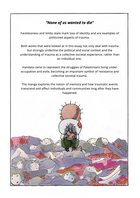
Leif Leo Nobel, Hanna Sauthoff, Clara Rasouli, Kai Nunez Wiklund
File [292Kb .pdf]
Title: The faces of trauma – (de)politicizing human suffering
Abstract
In this group project we have decided to work on the issues of trauma research and its depoliticization of human suffering. Lang (2018) criticizes scholars, especially in the field of humanities, who have often employed an essentialist and naturalized notion of trauma and advocates for a social constructivist approach, emphasizing that trauma classifications are social constructs influenced by political struggles and power dynamics. In our group project we want to look at two works from Japan and the Arab world. Our first work that we will be focusing on is the character of Handala created by Palestinian cartoonist Naji al-Ali in 1969. The boy became a symbol all over the Arab world of Palestinian trauma and resistance. The manga Cocoon by Machiko Kyō is based on the Lily Corps, schoolgirls who had to work as nurses and were active in Okinawa during WWII. The story is a fictionalized retelling of the events through a young girl’s eyes, and how she has to deal with the trauma of growing up in a tumultuous world surrounded by scary men, depicted as faceless, and how she and her peers have to deal with the collective trauma of trying to survive against all odds during the invasion of the island.
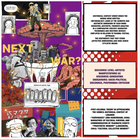
Monika Jagocha, Theodor-Mihai Dorin, Sarina Johansson
File [375Kb .pdf]
Title: Narratives of war, post-colonial history and collective memory: the case of I Think We Will Be Calmer in the Next War and Grave of the Fireflies
Abstract
The following report is a comparative analysis of two literary works exploring the trauma of war: Lebanese comics I Think We Will Be Calmer in the Next War by Lena Merhej, and Akiyuki Nosaka’s short story Grave of the Fireflies. To achieve the stated aim, the study utilises the analysis of narrative and aesthetic style, cultural contexts, and the role of remembering and learning the past.
Both works focus on presenting the trauma experienced by the civilians, and the way traumatic events affect their lives. By inserting autobiographical elements, both authors explore the importance of commemoration and challenging the silence: both that artificially induced by the state, as well as that of those whose voices were believed to be gone. The report aims to highlight the importance of the concept of survivance (Didi-Huberman, 2009) in trauma narratives as evoked in both works. What is more, employing Landsberg’s theory of prosthetic memory (2004), the analysis seeks to argue that both narratives contribute to the formation of a “public cultural memory” around the events of the war.
By comparing the narrative and aesthetic styles elected by the authors, this paper showcases different stylistic approaches to presenting the trauma of war. Nosaka’s choice of a linear narrative and realistic, vivid descriptions allows an immersive exploration of the horrors of war and the fight for survival. Merhej on the other hand opts for a nonlinear, fragmented narrative technique and symbolic visuals that showcase the chaotic nature of the war and the lingering effects of previous conflicts. Post-colonial theory will be used to tackle the portrayal of colonial history and its effects on both an individual and collective level, as well as questions of national identity and cultural narratives.
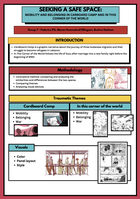
Bushra Sherif Galaleldin Hashem, Maren Hummelvoll Ellingsen, Federico Pili
File [3087Kb .pdf]
Title: Seeking a Safe Space: Mobility and Belonging in Carboard Camp and In This Corner of the World
Abstract
This project will analyze common themes in the two comic books In This Corner of the World (2007-2009) from Japan and Cardboard Camp (2023) from Lebanon. Both stories follow the lives of characters affected by war in their countries as they navigate new environments during and in the aftermath of traumatic events. In In This Corner of the World we follow Suzu Urano who marries into a new family and moves to Kure City during the second world war, and how she experiences this new life amidst challenges and traumatic events. Cardboard Camp depicts the lives of three Sudanese refugees from different war-torn regions in Sudan, namely Darfur, Kurdofan, and Nuba Mountains, who had to escape illegally and try to find safety in Lebanon. Despite the differences in historical, geographical, and temporal contexts, both stories carry similar themes that highlight the effect of traumatic experiences. These themes include mobility and freedom of movement, home and belonging, and the effect of wars on individuals and society. The analysis will utilize the visual aspects as well as the narrative in the comic books to showcase these themes. The aim of the project is to highlight how these themes can manifest in comic books and how collective trauma is can be parallel across borders.
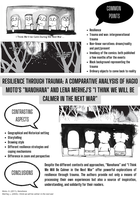
Sara Ferrari, Camilla Gertoux, Federica Mattioli
File [4274Kb .pdf]
Title: Resilience Through Trauma: A Comparative Analysis of Hagio Moto's "Nanohana" and Lena Merhej's "I Think We Will Be Calmer in the Next War"
Abstract
Our group project focuses on the comparative analysis of Nanohana" by Hagio Moto and "I Think We Will Be Calmer in the Next War" by Lena Merhej, analyzing how both authors deal with representing resilience through trauma.
"Nanohana" is a fictional manga that explores the lingering effects of the Fukushima nuclear disaster. The story delves into themes of loss, displacement, and the struggle to find normalcy after a catastrophic event.
In contrast, "I Think We Will Be Calmer in the Next War" is an autobiographical account set against the backdrop of the Lebanese Civil War. Merhej's work highlights the normalization of violence and the coping mechanisms developed by those who endure war conditions.
While both comics address the theme of coping with trauma, on the one hand, "Nanohana" focuses on the aftermath of a natural disaster, emphasizing a more introspective and somber tone. On the other hand, Merhej's work provides a snapshot of life in a war zone, using humor as a tool to process and survive the chaos of conflict. Together, these comics offer valuable insights into the human capacity for resilience in the face of different types of calamities.